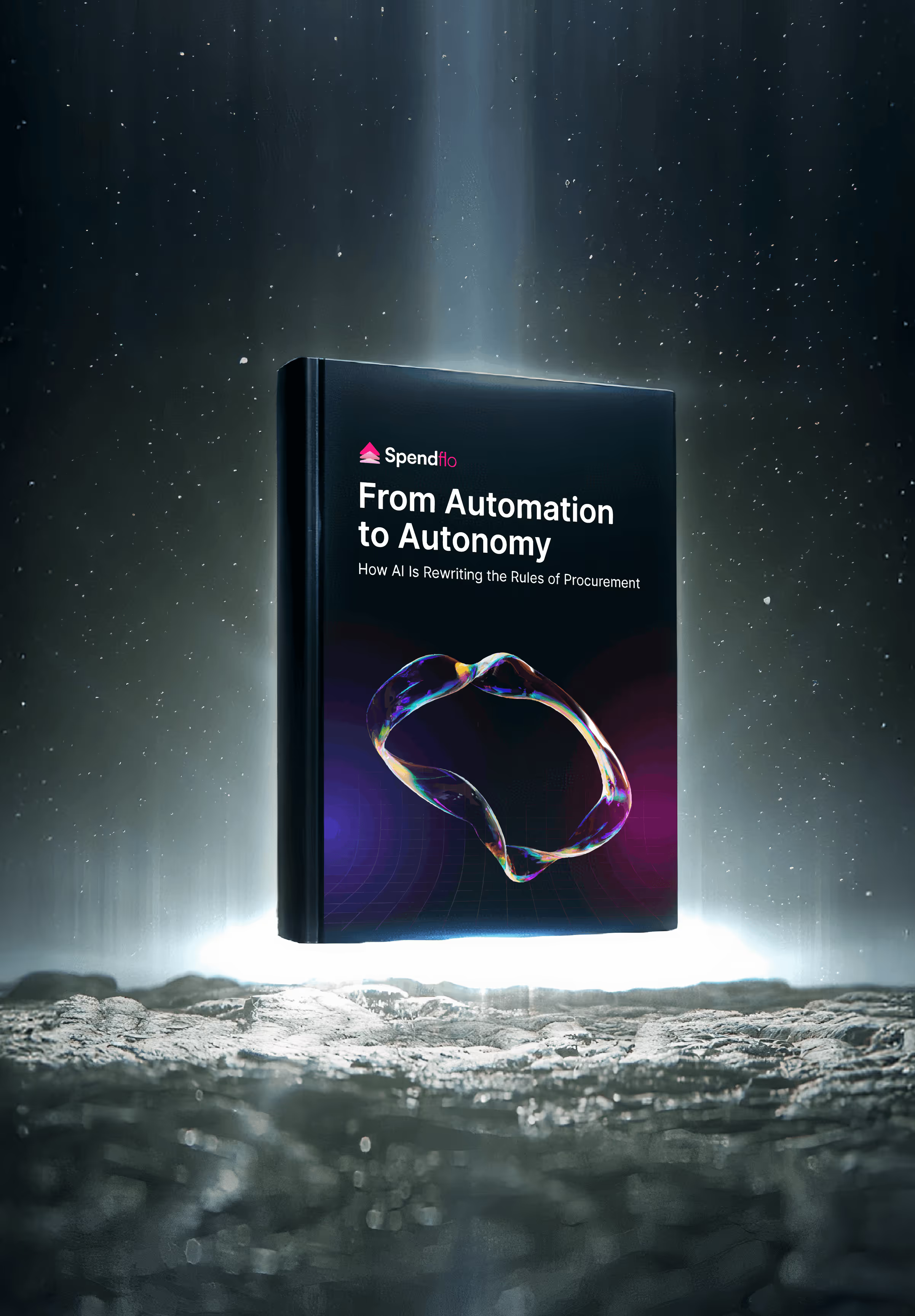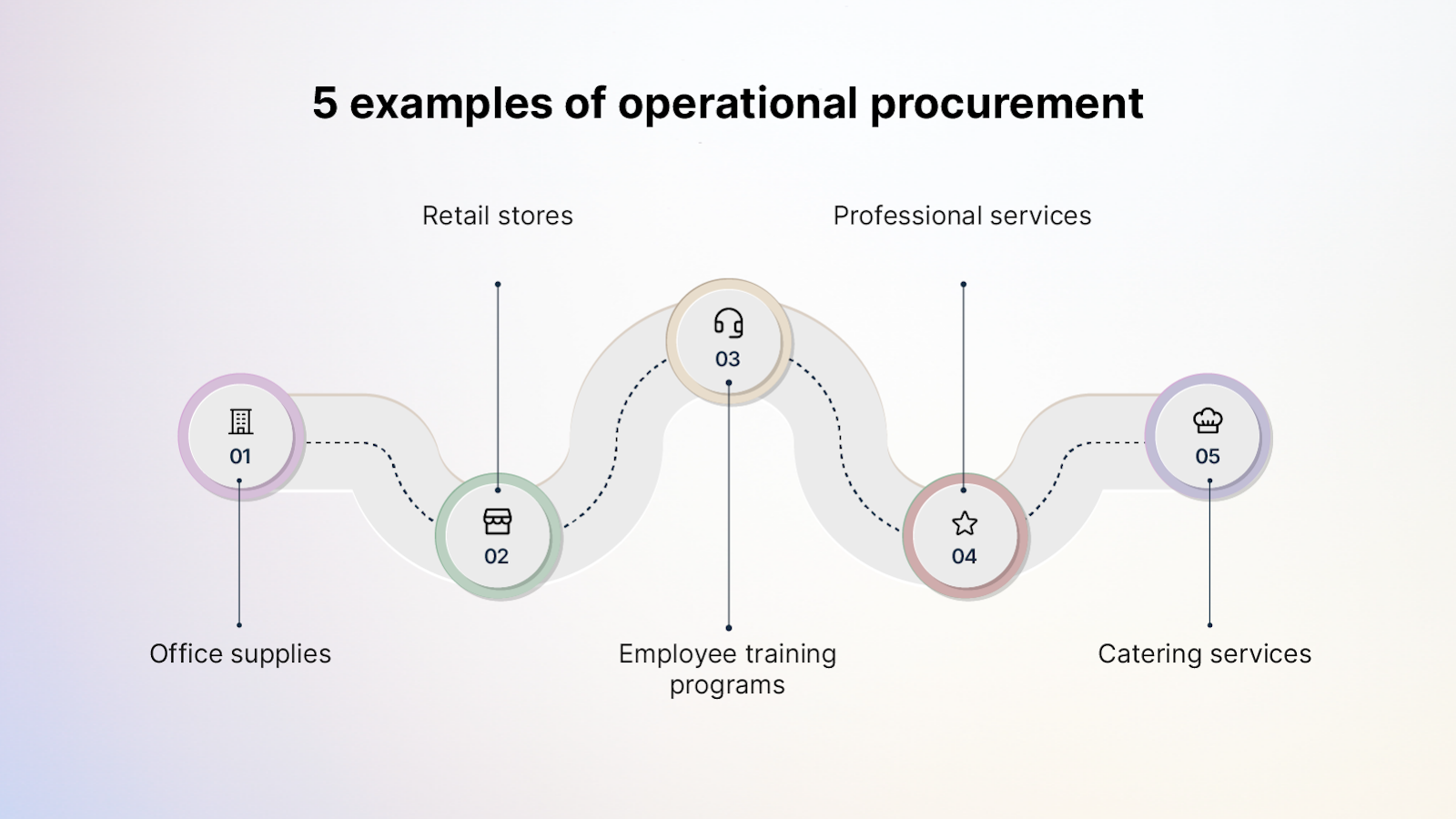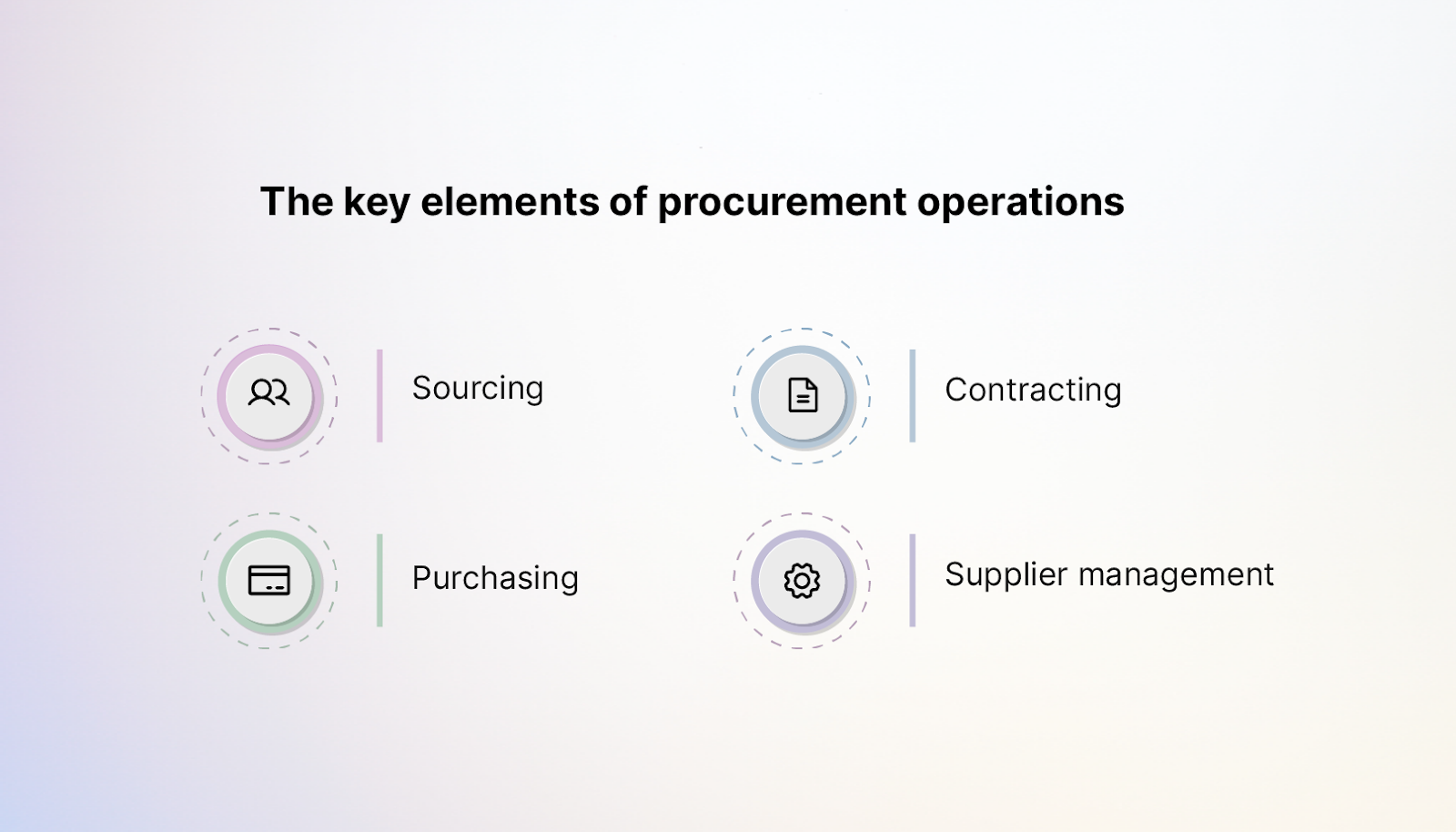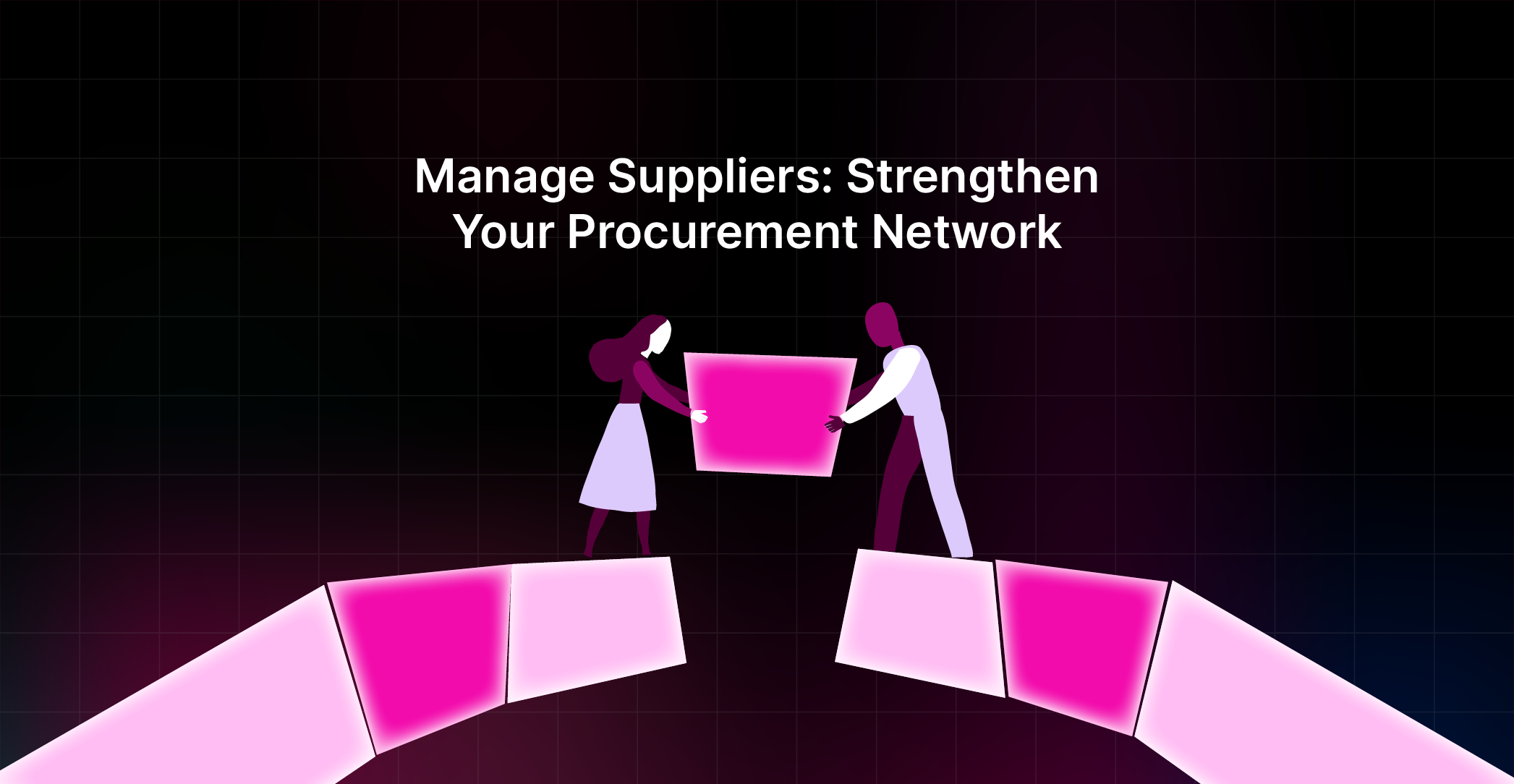

Operational Procurement: A Complete Guide to Procurement Operations in the SaaS Era

Operational Procurement: A Complete Guide to Procurement Operations in the SaaS Era
Learn what operational procurement is and how you can use SaaS procurement solutions to automate and make procurement operations more efficient.


Operational procurement is the foundation of day-to-day business continuity. Whether it’s sourcing office supplies, hiring catering services, or managing vendor contracts, procurement operations ensure that essential goods and services reach the right place at the right time - without delays or disruptions.
Yet, many businesses still struggle with inefficient workflows, supplier risks, and outdated systems. That’s where SaaS-based procurement solutions are changing the game. By automating manual processes, improving visibility, and enabling smarter decision-making, SaaS platforms are helping teams simplify operational procurement and focus on strategic goals.
In this blog, we’ll cover everything you need to know about operational procurement, including:
- What is operational procurement?
- Examples of operational procurement
- Benefits of operational procurement
- Challenges of procurement operations
- The key elements of procurement operations
- How automation adds value to procurement operations
- Salient segments where operational procurement works best
- How to optimize operational procurement
- Manage procurement operations with Spendflo
- Frequently asked questions on operational procurement
What Is Operational Procurement?
Operational procurement is the process of sourcing goods and services needed for daily business operations. It includes purchasing essential items like office supplies, utilities, or maintenance services. This ensures uninterrupted workflows and supports the organization’s efficiency and continuity.
Businesses that see themselves as fully sustainable and streamlined know that proper procurement processes are the wind beneath their wings. With time, they must categorize procurement to maintain a striking balance between quality assurance, cost optimization and an unending stream of operations in the company. The fundamental concept behind all this is operational procurement—the function that promises the timely acquisition of goods and services needed for daily operations.
From ordering to paying, operational procurement focuses on using and managing the essential resources so that the business faces no downtime. Today, when we see how technology is entering all sectors and moving in the right direction—we can say that in the operational procurement sector, we have SaaS procurement software making waves!
5 Examples Of Operational Procurement
Operational procurement touches nearly every corner of a business’s daily functions. From managing supplies to outsourcing services, these routine purchases keep operations running smoothly. Below are real-world examples that illustrate how operational procurement supports efficiency, continuity, and cost-effective decision-making across different business functions.

1. Office Supplies
Operational procurement works when your organization wants to purchase stationery and other must-have supplies for your office at regular intervals. From cartridges to cabins, your supplier will deliver as and when required.
2. Retail Stores
Retailers must be on top of their game and ensure their stock is never running low. Whether it’s merchandise or an item needed at the store, operational procurement processes are always active behind the scenes.
3. Employee Training Programs
If you wish to upskill your employees, you need to have a well-planned training program. It must include training materials, trainers, and access to e-learning platforms for your employees.
4. Professional Services
Professional services like legal, marketing, IT, accounting, and more outsource skills to companies and upgrade their business operations. The selection process examines their track record, industry experience, success rate, and client testimonials.
5. Catering Services
No event is complete without its food. Companies need catering services to manage events and meetings every week or month.
These examples illustrate the importance of operational procurement processes in the smooth functioning of a company.
Benefits Of Operational Procurement
Operational procurement isn't just about fulfilling daily needs - it's a driver of business efficiency, resilience, and long-term value. When done right, it reduces risks, promotes supplier diversity, and enhances overall performance. The following benefits show how effective procurement operations contribute to smoother workflows and smarter resource utilization.
1. Reduced Vendor Risk
Operational procurement minimizes the issues you can face while dealing with vendors and suppliers. It gains traction in the following areas while dealing with vendors:
- Finding trustworthy vendors: Always examine the stability, financial performance, track record, industry image, and other vendor factors during procurement. With operational procurement software, vendors are carefully selected and a reliable supply chain comes into the picture.
- Monitoring performance: You can monitor each vendor's performance before selecting and establishing a relationship with them. From delivery timelines to response rates, from product quality to delivery hassles, effective operational procurement practices detect issues quite early and address them.
2. Enhanced Supplier Diversity
Operational procurement fosters diversification by engaging with multiple suppliers, irrespective of their similarity in goods and services. By doing so, businesses will always have a steady second option if their preferred vendor falls short. In this age of inclusivity, organizations are looking to support suppliers from different backgrounds and minorities.
With supplier diversity, you can ensure that:
- Small businesses, individual-owned businesses, and other underrepresented groups get a fair chance of becoming a part of the supply chain.
- More jobs are available and people have the chance to increase their income. You are also encouraging economic empowerment and employment opportunities.
- Suppliers can bring different perspectives and suggestions that benefit the company. Many tech-advanced solutions, like the SaaS operations management model, result from such brainstorming sessions.
3. Improved Operational Efficiency
Operational efficiency during procurement leads to more cost savings, less use of the available resources and a more well-structured company culture. Here are some ways we see operational efficiency in the business:
- Operational procurement streamlines the process of sourcing, ordering, and paying for goods and services.
- The procurement process enables quicker response time by tracking spending and gaining insights from data analytics, which leads to faster decision-making.
- Most importantly, operational procurement helps save more time throughout the procurement stage. With more time in hand, you can utilize it productively in other areas of your business.
From sustainability to scalability, from time-saving to resource-saving, from inventory to workflow management, operational procurement keeps the company in check when using resources daily. This helps businesses to save and create a sustainable environment within the company.
Challenges Of Procurement Operations
As described further, the challenges in procurement operations refer to the obstacles you may face while acquiring goods and services from different suppliers. These issues, if resolved slowly, can impact the entire company.
1. Need To Adapt To Changing Tech
Every other day, a new technology comes up, which puts several companies into a state of confusion. Similarly, in operational procurement, several tools and software have come to the forefront to keep the entire industry efficient and competitive in their standings. Keeping up with the rapidly changing technology, understanding integrations, and enabling data security can be overwhelming for most companies.
However, businesses need to adapt to changing tech as that will help in their growth and future-proofing. Long-term efficiency and relevance are what companies must aim for whenever they choose a technological solution. For example, procurement automation and its interaction with the SaaS model have taken businesses in their nascent stage from strength to strength.
2. Changing Regulations
Another challenge of procurement operations is a “constant change” in the industry's requirements. You must update your processes, comply with the laws, and imbibe specific standards while acquiring goods and services. You must observe and practice these changing legalities and regulations with an eagle's eyes.
Some of the complications that arise whenever regulations change are:
- Legally, you must stay abreast of the trade regulations, compliance laws, and other industry-specific laws. It’s a demanding process, right from understanding to implementation.
- Geographically, every country has a different law concerning trade and procurement practices. Adhering to this highly diverse platter of laws is tough.
- Ethically and environmentally, the global market encourages procurement practices that benefit people from all backgrounds and our environment, from fair labor management to carbon footprint reduction.
3. Complex Procurement Process
Procuring goods and services for your firm's smooth functioning will not always be a cakewalk. It’s a lengthy process that includes the following:
- Timely approvals
- Right suppliers
- Adherence to rules
- Paperwork and documentation
- Team coordination
- Tracking timelines
- Ensuring cost and quality efficiency.
Such complex processes can slow down the company, making it inefficient and reducing profits. Procurement automation is one of the best solutions to solving this complexity and ensuring orderliness throughout the company.
Key Elements Of Procurement Operations
Behind every efficient procurement operation lies a set of well-defined building blocks. These key elements - from sourcing to supplier management - create the foundation for a streamlined, transparent, and repeatable process. Understanding each step ensures better control over costs, timelines, and supplier relationships across the procurement lifecycle.

1. Sourcing
Sourcing is the first step, wherein you identify, evaluate, and select the supplier who can provide you with everything you need for your company. This step demands thorough market research and verification of the suppliers. Once you establish credibility with the supplier, you can work long-term with them.
For example, if you need a supplier for your office, you will first observe that they provide high-quality supplies that fit your bill. You must also compare many suppliers and negotiate pricing to get the best value upon order completion.
2. Contracting
The next step of procurement operations is going formally and legally with your suppliers. You must draft the terms and conditions between your company and the supplier. The contract's decided prices, delivery schedules, and order timelines are clearly defined.
For example, if you get a contract with a caterer, you will check that the quality of the food and its prices balance each other. The agreement must include the quality standard, delivery timeline, and essential information.
3. Purchasing
Purchasing is the act of actually placing an order and purchasing from the vendor. The contract must meet the pre-decided factors. This ensures transparency between both parties, i.e., one receives what they need and the other gets the pre-decided amount.
For example, advertising and marketing agencies provide special services for companies expanding on social media. It could be a blog, a social media calendar, or a template, which, when delivered to the company at fixed prices and quantities, the agency will receive compensation.
4. Supplier management
It makes no sense when businesses rely on just one supplier for their goods and services. Over time, they need to identify and establish relations with a supply network so that there’s always someone to fall back on. Supplier management includes performance monitoring, updating terms and conditions, resolving disputes, etc.
For example, when dealing with courier delivery services, you will have to monitor their speed and quality of service to decide which one to go with the next time. If any issue arises, you need to resolve it immediately via the supplier management process.
These four key elements must blend to carry out your procurement operations successfully. They add structure to the entire process, from acquiring goods and services to maintaining healthy supplier tie-ups.
Salient Segments Where Operational Procurement Works Best
Operational procurement delivers the most value when applied to specific, high-impact segments of day-to-day business. These areas benefit from well-defined processes, timely execution, and reliable supplier coordination. Let’s explore where operational procurement shines the brightest and contributes directly to organizational efficiency and performance.
1. Supplier Selection
Operational procurement identifies and chooses the best suppliers to meet your company’s needs. Market research, supplier verification, conditions in agreements, and other negotiations play an active role in this segment. You must never ignore this process, as it ensures that your goods and services come from reliable channels at the best quality and pricing.
2. Order Monitoring
Order monitoring is overseeing the status of orders from their approval to delivery. Upon delivery, the goods and services must be of the promised quality and if any issue arises, the procurement team works with the supplier to resolve it.
3. Invoice Process
Since there are multiple invoices, procurement automation verifies supplier invoices. It ensures that they are accurate, match the order requirement, and are timely closed. These financial transactions find their space for record-keeping and auditing purposes.
How To Optimize Operational Procurement
Optimizing operational procurement goes beyond automating tasks - it’s about building a smarter, more responsive process that aligns with business goals. From standardizing workflows to leveraging real-time data, the right strategies can improve accuracy, reduce costs, and enhance supplier collaboration. Here’s how to make your procurement operations more effective.

1. Automate Procurement Processes
Implement SaaS procurement software to automate routine tasks like order creation, workflow approvals, delivery monitoring, invoice processing, etc. You will minimize procurement risks when the role of manual efforts becomes negligible.
2. Standardize Procurement Processes
Establish a particular way of operational procurement in your company for your employees to follow. Whether it’s contract management or finalizing payments, this standardization will act as a guide, ensuring clarity and consistency throughout your company.
3. Use Appropriate Technology
If you’re hands-on with procurement operations, you will know the advanced solutions you need. From gaining real-time data about operations to deploying vendor intelligence systems, use SaaS management tech that will be your company's game-changer.
How Automation Adds Value to Procurement Operations
Automation is no longer a luxury in procurement - it’s a strategic necessity. As businesses face evolving market trends, supplier volatility, and rising expectations for speed and accuracy, automated solutions provide the structure and intelligence needed to stay competitive.
1. Smarter Vendor Management
An automated vendor management system centralizes supplier data, performance metrics, and contract terms - making it easier to track obligations, prevent compliance issues, and reduce delays. Tools like the supplier risk scorecard help you assess and proactively manage vendor reliability and delivery timelines.
2. Faster Supplier Enablement and Integration
With traditional procurement, supplier Enablement Services can be time-consuming. Automation streamlines onboarding, ensures regulatory compliance, and facilitates Seamless Supplier Integration - whether you’re working with a small local vendor or a large international supplier.
3. Ethical and Inclusive Procurement Practices
Automation supports ethical sourcing practices by embedding transparency and accountability into every stage of the procurement process. Whether you're prioritizing fair labor, environmental compliance, or diversity in suppliers, digital workflows help enforce these standards consistently.
4. Adaptability to Market Changes
Automated systems provide real-time visibility and data-backed insights, helping businesses react quickly to market changes - from price fluctuations to supply disruptions. This agility ensures your procurement operations remain resilient and aligned with business needs.
5. End-to-End Optimization
From purchase requisition to invoice settlement, automation improves efficiency across the entire procurement workflow. Teams gain better control over spend, reduce processing errors, and shorten cycle times - freeing up resources for strategic initiatives.
How Spendflo Can Help Streamline Operational Procurement
Spendflo is purpose-built to simplify and modernize operational procurement in SaaS-driven organizations. From purchase requisitions to vendor management and contract negotiation, Spendflo centralizes your procurement workflows in one intuitive platform - helping you scale with speed, compliance, and confidence.
Here’s how Spendflo adds value:
- Automated Procurement Workflows: Eliminate manual processes across order processing, streamlines Accounts Payable and order processing approvals, goods receipt, and Accounts Payable.
- Spend Visibility & Control: Track real-time spend across departments to identify cost reduction opportunities and reduce purchasing costs.
- Vendor Management System: Manage suppliers with performance insights, supplier risk scorecards, and seamless onboarding through supplier Enablement Services.
- SaaS Optimization: Tailored for SaaS businesses, Spendflo supports centralized procurement with built-in analytics to reduce redundancy and enable better contract negotiation.
- Compliance & Collaboration: Ensure audit-ready procurement with version-controlled documentation, ethical sourcing practices, and secure workflows that promote internal alignment and supplier collaboration.
Frequently Asked Questions on Operational Procurement
What is operational procurement and how does it support supply chain management?
Operational procurement refers to the routine process of acquiring goods and services required for daily business needs. It plays a critical role in supply chain management by ensuring timely order processing, accurate inventory management, and strong vendor relationships. By focusing on execution rather than strategy, it helps businesses maintain uninterrupted operations.
How does operational procurement in SaaS differ from traditional systems?
Operational procurement in SaaS leverages cloud-based platforms to automate procurement tasks, enhance data accuracy, and enable real-time collaboration. Unlike traditional systems, SaaS tools improve purchase requisition flows, reduce error rates, and offer integrated dashboards for managing goods receipt, Accounts Payable, and delivery management efficiently across locations.
What’s the difference between centralized and decentralized procurement in operational procurement?
Within operational procurement, centralized procurement involves a unified team managing purchases, enabling better visibility and cost reduction. On the other hand, decentralized procurement allows individual departments to manage buying decisions, offering flexibility but increasing risks of maverick spend if not automated. Both models benefit from SaaS platforms that offer control without sacrificing speed.
How do SaaS tools support supplier collaboration and integration?
SaaS-based procurement systems streamline supplier Enablement Services, allowing for faster onboarding and Seamless Supplier Integration. They also support better supplier collaboration through automated communication, shared performance tracking via supplier risk scorecards, and nurturing strong relationships across your vendor ecosystem.
How do digital solutions help manage market changes and trends?
Digital solutions provide real-time insights that help procurement teams respond quickly to market changes and stay aligned with evolving market trends. They also enhance decision-making across contract negotiation, Request for Quotations, and budgeting, supporting both operational agility and strategic foresight.
How does automation lower purchasing costs and reduce errors in operational procurement?
Automation helps reduce purchasing costs by streamlining purchase requisition and Accounts Payable processes, improving compliance, and cutting down on delays. It also reduces the error rate by eliminating manual entry issues during goods receipt and payment processing.
How does operational procurement support ethical sourcing practices and modern procurement roles?
Modern procurement roles are evolving to prioritize ethical sourcing practices, supplier diversity, and sustainability. Operational procurement, especially when supported by SaaS platforms, ensures transparency, compliance, and accountability from sourcing to settlement, aligning day-to-day execution with company values.












.avif)




.png)















